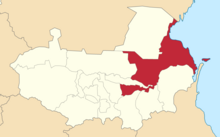The Kizlyarsky otdel[a] was a Cossack district (otdel) of the Terek oblast of the Caucasus Viceroyalty of the Russian Empire. The area of the Kizlyarsky otdel makes up part of the North Caucasian Federal District of Russia. The district was eponymously named for its administrative center, Kizlyar.[2][page needed]
Kizlyarsky otdel
Килярскій отдѣлъ | |
|---|---|
 Location in the Terek Oblast | |
| Country | Russian Empire |
| Viceroyalty | Caucasus |
| Oblast | Terek |
| Established | 1785 |
| Abolished | 1924 |
| Capital | Grozny[1] |
| Area | |
| • Total | 5,756.56 km2 (2,222.62 sq mi) |
| Population (1916) | |
| • Total | 136,749 |
| • Density | 24/km2 (62/sq mi) |
| • Urban | 11.81% |
| • Rural | 88.19% |
Administrative divisions edit
The subcounties (uchastoks) of the Kizlyarsky otdel were as follows:[3]
| Name | 1912 population |
|---|---|
| 1-y uchastok (1-й участок) | 15,007 |
| 2-y uchastok (2-й участок) | 28,325 |
| 3-y uchastok (3-й участок) | 19,194 |
| 4-y uchastok (4-й участок) | 35,290 |
Demographics edit
Russian Empire Census edit
According to the Russian Empire Census, the Kizlyarsky otdel had a population of 102,395 on 28 January [O.S. 15 January] 1897, including 53,605 men and 48,790 women. The majority of the population indicated Russian to be their mother tongue, with a significant Nogai speaking minority.[4]
| Language | Native speakers | % |
|---|---|---|
| Russian | 53,785 | 52.53 |
| Nogai | 31,650 | 30.91 |
| Armenian | 4,681 | 4.57 |
| Ukrainian | 4,139 | 4.04 |
| Kalmyk | 1,417 | 1.38 |
| Georgian | 1,030 | 1.01 |
| Turkmen | 1,029 | 1.00 |
| Kumyk | 988 | 0.96 |
| Tatar[b] | 955 | 0.93 |
| Chechen | 864 | 0.84 |
| Dargin | 571 | 0.56 |
| Persian | 233 | 0.23 |
| Kazi-Kumukh | 195 | 0.19 |
| Polish | 177 | 0.17 |
| German | 113 | 0.11 |
| Romani | 107 | 0.10 |
| Ossetian | 105 | 0.10 |
| Jewish | 104 | 0.10 |
| Avar-Andean | 101 | 0.10 |
| Ingush | 41 | 0.04 |
| Circassian | 13 | 0.01 |
| Greek | 13 | 0.01 |
| Belarusian | 8 | 0.01 |
| Romanian | 8 | 0.01 |
| Kabardian | 7 | 0.01 |
| Lithuanian | 7 | 0.01 |
| Imeretian | 2 | 0.00 |
| Karachay | 2 | 0.00 |
| Other | 50 | 0.05 |
| TOTAL | 102,395 | 100.00 |
Kavkazskiy kalendar edit
According to the 1917 publication of Kavkazskiy kalendar, the Kizlyarsky otdel had a population of 136,749 on 14 January [O.S. 1 January] 1916, including 71,901 men and 64,848 women, 119,287 of whom were the permanent population, and 17,462 were temporary residents:[7]
| Nationality | Urban | Rural | TOTAL | |||
|---|---|---|---|---|---|---|
| Number | % | Number | % | Number | % | |
| Russians | 6,522 | 40.38 | 86,774 | 71.95 | 93,296 | 68.22 |
| Sunni Muslims[c] | 0 | 0.00 | 28,294 | 23.46 | 28,294 | 20.69 |
| Armenians | 6,203 | 38.41 | 998 | 0.83 | 7,201 | 5.27 |
| Shia Muslims[d] | 687 | 4.25 | 2,745 | 2.28 | 3,432 | 2.51 |
| North Caucasians | 1,726 | 10.69 | 691 | 0.57 | 2,417 | 1.77 |
| Georgians | 438 | 2.71 | 746 | 0.62 | 1,184 | 0.87 |
| Jews | 420 | 2.60 | 152 | 0.13 | 572 | 0.42 |
| Other Europeans | 155 | 0.96 | 198 | 0.16 | 353 | 0.26 |
| TOTAL | 16,151 | 100.00 | 120,598 | 100.00 | 136,749 | 100.00 |
Notes edit
- ^
- ^ Before 1918, Azerbaijanis were generally known as "Tatars". This term, employed by the Russians, referred to Turkic-speaking Muslims of the South Caucasus. After 1918, with the establishment of the Azerbaijan Democratic Republic and "especially during the Soviet era", the Tatar group identified itself as "Azerbaijani".[5][6]
- ^ Primarily Turco-Tatars.[8]
- ^ Primarily Tatars.[8]
References edit
- ^ Кавказский календарь на 1911 год, col. 177.
- ^ Tsutsiev 2014.
- ^ Кавказский календарь на 1913 год, pp. 180–187.
- ^ a b "Демоскоп Weekly - Приложение. Справочник статистических показателей". www.demoscope.ru. Retrieved 2022-07-09.
- ^ Bournoutian 2018, p. 35 (note 25).
- ^ Tsutsiev 2014, p. 50.
- ^ Кавказский календарь на 1917 год, pp. 226–237.
- ^ a b Hovannisian 1971, p. 67.
Bibliography edit
- Bournoutian, George A. (2018). Armenia and Imperial Decline: The Yerevan Province, 1900–1914. Milton Park, Abingdon, Oxon: Routledge. ISBN 978-1-351-06260-2. OCLC 1037283914.
- Hovannisian, Richard G. (1971). The Republic of Armenia: The First Year, 1918–1919. Vol. 1. Berkeley: University of California Press. ISBN 978-0520019843.
- Кавказский календарь на 1911 год [Caucasus calendar for 1911] (in Russian) (66th ed.). Tiflis: Tipografiya kantselyarii Ye.I.V. na Kavkaze, kazenny dom. 1911. Archived from the original on 31 January 2022.
- Кавказский календарь на 1913 год [Caucasian calendar for 1913] (in Russian) (68th ed.). Tiflis: Tipografiya kantselyarii Ye.I.V. na Kavkaze, kazenny dom. 1913. Archived from the original on 19 April 2022.
- Кавказский календарь на 1917 год [Caucasian calendar for 1917] (in Russian) (72nd ed.). Tiflis: Tipografiya kantselyarii Ye.I.V. na Kavkaze, kazenny dom. 1917. Archived from the original on 4 November 2021.
- Tsutsiev, Arthur (2014). Atlas of the Ethno-Political History of the Caucasus (PDF). Translated by Nora Seligman Favorov. New Haven: Yale University Press. ISBN 9780300153088. Archived (PDF) from the original on 17 June 2023.